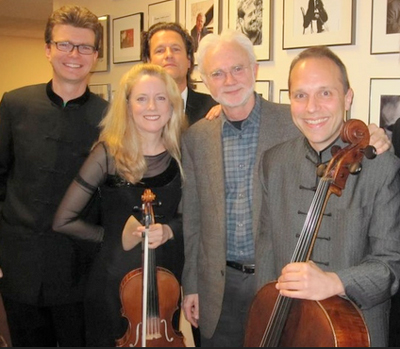by Daniel Hathaway

Dalby will join violinist Geoff Nuttall, violist Lesley Robertson, and cellist Christopher Costanza on Friday evening in Joseph Haydn’s Quartet in f, Op. 20, No. 5, John Adams’s Second String Quartet, and Ludwig van Beethoven’s Quartet in a, Op. 132.
Originally formed in Canada, the St. Lawrence has been in residence at Stanford since 1999.“We really didn’t know what we were getting into,” Nuttall said in a telephone conversation. “We were living in New York and freelancing when we came out to visit. Condoleezza Rice was the provost — a great pianist — and the president of the University was a big music lover. They basically said, OK, if you were the quartet in residence at Stanford, what would you do?”
Nuttall said that coming up with an idea to fit the Stanford situation wasn’t rocket science. “For the most part, we’re inspiring doctors and biotech engineers and computer scientists to go out into the world and have the power of music be an important part of their lives. A lot of what we do is make on-campus connections using the quartet as an ambassador. For example, we gave a presentation at a new biotech engineering building on Haydn’s Op. 20, No. 5, drawing a link between intellect and emotion, and talking about the building blocks that make music great. That quartet ends with a fugue, which was an obvious connection for scientists, and we talked about sonata form and how a movement is put together. By exposing students to music, we’re also inspiring a new wave of philanthropists to support classical music in Silicon Valley.”
The residency has also inspired the ensemble’s relationship with one of the greatest living American composers. “John Adams came to a concert the quartet gave at Stanford about ten years ago. We played his John’s Book of Alleged Dances and Beethoven’s Op. 132, and he said, ‘You guys are incredible. I want to write a quartet for you.’ Well, how cool, we thought, but how are we going to pay for it? ‘It’s already taken care of,’ he said.”
To date, that relationship has resulted in three works: the String Quartet, Absolute Jest for quartet and orchestra, and the Second String Quartet. “It’s been an amazing run with John,” Nuttall said. “We just held the first of three concerts celebrating his 70th birthday. He came to Stanford and gave a talk, and we played his Suite of Alleged Dances. Each one of the pieces we’ve done with him has undergone massive changes from the premiere to the way that it is now. That process wouldn’t have happened if we hadn’t had close access to the composer and the luxury of long rehearsals. It was really interesting throwing ideas back and forth. He’s a rarity, an amazing combination of confidence and total openness to suggestions.”
Nuttall describes the Second String Quartet as “Beethoven’s Op. 110 deconstructed into a cosmic dream.” Adams started out purely as a minimalist, Nuttall said, “but he’s incorporated many more influences into the mix. The idea of the ‘groove’ is still crucial, but there are moments of tranquil beauty that remind you of Ravel and Stravinsky.”
Haydn’s Op. 20 quartets, of which the St. Lawrence will play No. 5 in f-minor at Oberlin, have also provided fertile material for the Stanford residency. “Op. 20 is the beginning of the string quartet as we know it, and also the end in many ways,” Nuttall said. “There’s a through line from Op. 20 through late Beethoven: the fugal writing, the overt expressiveness, the quirkiness.
“We did a MOOC (Massive Open Online Course) with a musicologist that was a history of the string quartet as seen through the eyes of Op. 20, No. 5,” Nuttall said. “It’s somewhat academic, but it’s fun, and free, and everything expands like spokes of a wheel from that quartet. You can do as little or as much as you like. You can listen to a performance, or hear discussions about fugal writing or about sonata form. It’s pretty cool.”
Concluding our conversation, Geoff Nuttall reflected on the magical cross-pollination that can take place between contemporary music and masterworks of the past. “Working with a living composer like John Adams really gives you insight into Haydn and Beethoven. And then you take the same sense of reverence and dedication you apply to Haydn and Beethoven into working with a contemporary composer. It’s the combination of living and dead, classical, romantic, and modern that makes the experience so powerful.”
Published on ClevelandClassical.com November 8, 2016.
Click here for a printable copy of this article



